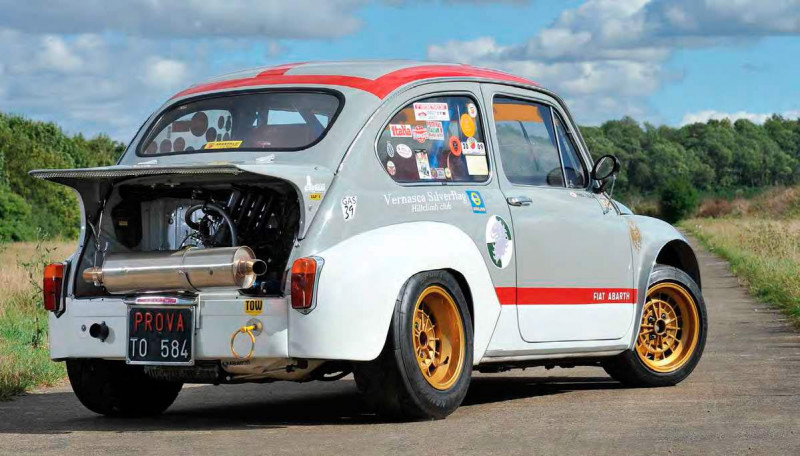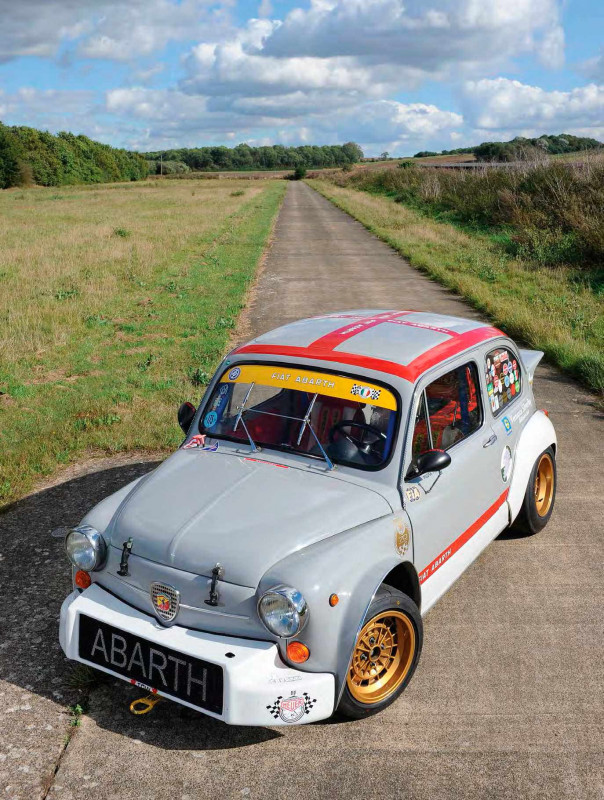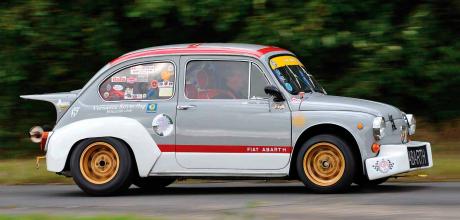1970 Fiat-Abarth 1000 TC Corsa wide-body racer tested on track
Strap in for a wild ride as we get behind the wheel of a Group 5 race-spec Fiat-Abarth 1000TC Corsa Wide Body. Story by Chris Rees. Photography by Michael Ward.
Wide Yet Narrow
WIDE BOY ABARTH 1000TC CORSA
Wings bulging like a bodybuilder’s biceps, massive chin jutting forward like a Victorian circus performer, engine lid raised like the tail on a boxer dog – the word ‘pugnacious’ could have been coined specifically for this car. While so many of Carlo Abarth’s creations have a delicacy and litheness to them, you could never say that of Mike Kason’s 1000TC Corsa racer. It’s not only wide of body but also, as I’m about to discover, a bit of a wide boy in terms of character – a street-fighting David to the established Goliaths.

Mike describes Abarth’s 850 and 1000 Berlina models as “perhaps the first purpose-built touring car in the world”, which dominated the under-1000cc class in the early days of the ETCC and WEC. Carlo Abarth’s modified versions of the Fiat 600 were fully supported by Fiat, and the House of the Scorpion succeeded in building enough cars to homologate them for Group 2. Among the model’s ground-breaking innovations were the first homologated five-speed gearbox and homologated all-round disc brakes.
“ The 1.0-litre engine is perfectly happy to go to 9000rpm. With 130hp and 560kg, it regularly overtakes Giulia GTAs on track ”
In 1968 came new rules and Group 5 cars. Abarth seized the moment with massive development, resulting in considerable racing success. In particular, the 1000 TC, with its power raised to more than 100hp, became a true monster. By 1970, it had gained the burly new wide bodywork you see on Mike’s car, designed to clear the larger wheels and tyres.

First registered on 18 February 1970, this charismatic machine has been owned by Mike for the last seven years, having been bought from Dutch enthusiast Ad Van Ling. Ad had discovered what was then a pukka Fiat-Abarth 850TC in Ireland back in 1996. Repatriated to the Netherlands, Ad fitted a larger 1050cc engine, applied for his first race licence and then took to the tracks. He was immediately successful, finishing second in class in the Dutch championship and then winning the up-to-1300cc class at the 1998 Italia Zandvoort meeting. However, at the following year’s Zandvoort event, he had bad crash in qualifying on the notorious Scheivlak corner. The car had to be reshelled using a body fitted with Abarth-style strengthening, and all the original Abarth kit was swapped over to it.
Once purchased by Mike, it was restored by himself and Carlo Caccaviello in 2014, including bare metal bodywork. All non-correct parts were removed and replaced with correct original specification parts; other than the bodyshell, everything is genuine Abarth.
The car was duly UK-registered in July 2015. It’s a wide-body Group 5-spec car with FIA Historic Technical Papers, an MSUK Passport and DMSB Wagenpass. As the panoply of stickers in the rear windows attest, this example has a long racing history that stretches back many years across Club, European and International events. It’s appeared at Goodwood, Brands Hatch, Hockenheim (FIA Jim Clark Historic), Adamello Historic, Historic Abarth Track Days at Varano and Franciaorta, Scalata Al Colle Sant’Eusebio Classic, Nostalgia Club Berzo Demo-Cevo Classic and Chateau De Savigny-les- Beaune Anniversaire. Above all, it has appeared no fewer than 15 times at the Vernasca Silver Flag hillclimb – handy as Mike’s wife owns a house in the Castell’Arquato area.
The 1000 TC looks fantastic in the metal, with its two-tone grey paint supplemented by red stripes that extend to a cross pattern on the roof (an original Abarth feature). Open the super-light door (all the windows are Lexan except the windscreen) and make your way past the OMP six-point rollcage and you’re greeted by a very focused cabin. Settle into the period Cobra seat with its custom ‘Abarth’ script and strap on the six-point belts. Time to appreciate the Abarth dash pod ahead of you, filled with delicious Jaeger dials. What’s this on the far side of the facia – a signature? Yes, the familiar scrawl of the famous Italian, Texanhatted, ex-Abarth racing driver, Arturo Merzario.
In the spec that Ad Van Ling used, the 1.0-litre engine boasted 90hp at 7000rpm. This engine has since been replaced with a 983cc unit built by the well-known Italian engine constructor, GAS39, which was previously fitted to Saverio Miglionica’s Autobianchi A112 Abarth race car (this competed in 49 Italian hillclimb and slalom championship races – and won 48 of them!). The fuel-injected unit boasts a mighty 130hp, all from less than one litre. It’s cooled by front-mounted water and oil radiators, supplemented by thermostatically operated fans; these are housed within an original-specification Abarth cover that juts out up front in spectacular style. The frontal radiator placement means that cooling is at its most efficient, while the extra weight in the nose also helps balance the handling.
The gearbox is a very rare Colotti Abarth five-speed, fully £9000 worth of kit. It’s extremely tricky to engage.
Dogleg first is down and to the left. Is it in? No. Try again. Still no. Lift the clutch pedal slightly and the lever now has a chance to engage. This is a technique I recognise from my Moto Guzzi-engined motorbike-gearbox Triking; you just have to crunch and bear it.
It takes a while to get used to the gate, too, as I discover on my first attempted up-change from first, going straight to fourth and causing the engine to bog down. When I finally learn to engage the gears in their correct sequence, it becomes second nature to move around the ’box. The driveshafts, by the way, are robust forged steel items with Hardy Spicer joints. The 1.0-litre Abarth engine really does beg for revs – the tachometer is reading well above 4000rpm before things really start to get going. I’m self-limiting the revs to 7000rpm today to keep things safe but apparently the engine is perfectly happy to go to 9000rpm. On fast circuits such as Brands Hatch and Castle Combe, Mike gets to use fifth gear and he has seen the speedo go right off the clock (at an indicated 170km/h). That means the car probably topped out at over 110mph – not bad for a little Fiat 600! With 130hp in a car weighing just 560kg, it’s no surprise to hear that Mike regularly overtakes Alfa Romeo Giulia GTAs on track. And it can keep going, too, thanks to its long-range, 70-litre, foam-filled fuel tank (with lifter pump, swirl pot, filter and fuel pressure regulator, plus lines by Earl’s). The MSUK-legal exhaust is by Fusion Fabrications and has a silencer so it’s not outrageously loud, but it certainly sounds intense – just as you’d hope from an Abarth (a brand whose origins, after all, lie in supplying uprated exhausts).
Lurking behind the Middle Barton Garage gold Campagnolo alloys (13x6 front, 13x8 rear) are Abarth Girling brake callipers and discs with a ‘lobster-claw’ handbrake mechanism. The brake pedal delivers unbelievably powerful performance and is both sharp and full of feel. At the end of my spin around the track, Mike wipes his finger over the alloy wheel and shows me a layer of dust: “Yes, the brakes work!”
The front suspension is by adjustable coilover dampers with 40mm lowered front uprights, while at the rear you have lowered coil springs and dampers. Adjustable anti-roll bars are fitted both front and rear. The ride is hard but not crushingly so, while the cornering stance is very flat indeed. With so little weight over the front end, the steering feels very direct. If you take too much speed into a turn, the front end will understeer. If you lift off, the weight transfer tightens your line but also makes the rear end go light. It feels like a classic Porsche 911 in this regard, with lift-off oversteer lurking ominously.
Mike laughs about this trait: “If you haven’t rolled the car at least once, you haven’t been trying hard enough!” Well, on the day of my test, I was clearly not trying hard enough as, mercifully, I didn’t roll it. What the rear-engined layout definitely provides is fantastic traction, allowing you to apply power early on in each apex. Nankang tyres (175/50 R13 front, 205/60 R13 rear) offered tremendous grip in the dry conditions of our test but are, says Mike, “useless in the wet”.
Overall, this little TC Corsa feels very much a circuit car to drive, although Mike has MOT’d and taxed it and has driven it on the road. Me? It’d have to be a hillclimb! I loved driving this little car around our tight test circuit. Of course, it’s not the fastest thing on the planet but it has the capacity to surprise far more potent machinery, thanks to its light weight, zingy power delivery and tenacious handling. Just like it did in its giant-killing Group 5 days.
983cc engine comes from an A112 Abarth racer. Huge 70-litre fuel tank gives tremendous range for endurance racing.
Extended arches cover very wide wheels. Glassfibre ‘engine lid’ doesn’t need supports. Arturo Merzario’s signature adorns facia


